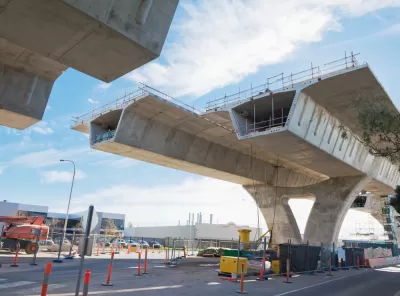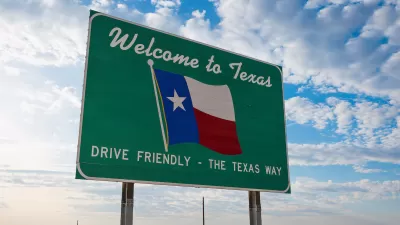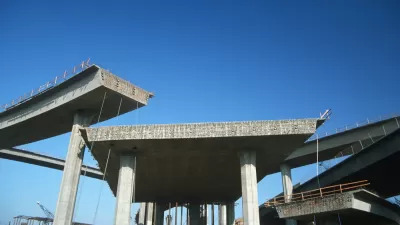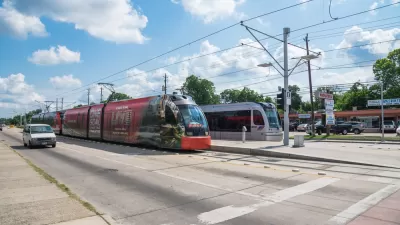Kenneth Orski, editor and publisher of Innovation NewsBriefs, examines how state governments are beginning to accept more responsibility for transportation funding.

The Obama Administration's fiscal year 2016 budget proposal has been declared a nonstarter by Republicans in Congress.
The proposed budget would fund infrastructure through a mandatory 14 percent tax on accumulated overseas earnings of U.S. companies (regardless of whether the earnings are repatriated or not). The proposal's powerful list of opponents includes Senate Finance Committee Orrin Hatch (R-UT) and House Ways and Means Committee Paul Ryan (R-WI). According to Senator Hatch, repatriation of corporate earnings may be a legitimate component of true tax reform, but it should not be used as an excuse for extravagant spending. Instead, any taxes on foreign earnings should be used to reduce the debt or to pay for structural changes in the tax code.
The administration's proposal would bring in $238 billion which, combined with $240 billion from the Highway Trust Fund, would fund a $478 billion six-year surface transportation bill. At $80 billion a year, the program would be spending twice as much as under current law.
While some observers believe there is still a possibility of an eventual compromise on corporate tax reform, the expiration of the current transportation bill at the end of May might require Congress to look for more immediate ways of funding the surface transportation program.
The money needed to keep the federal transportation program funded at current spending levels is substantial. The Congressional Budget Office estimates that the bill would require an extra $15 billion in general funds each year just to maintain the program at current spending levels. A six-year bill would require $90 billion in subsidies. The annual shortfall is the difference between the current (FY 2015) level of federal spending ($53 billion) and the revenue derived from the federal gas tax and interest ($38 billion).
Shifting a larger share of funding to the states
Since a gasoline tax increase has been firmly ruled out both by the White House and the Republican House leadership, the most realistic and timely solution might be to shift a larger share of funding responsibility to the state and local level. Transportation advocacy group Transportation for America (T4America) is among the supporters of such a change in the transportation funding landscape. "States that want to continue investing will have to explore new ways to raise funding for transportation on their own," said T4America Director James Corless in announcing the launch of a new initiative that supports efforts to raise transportation funding through state legislation.
T4America's approach is backed by solid evidence. In 2015, at least 20 states are poised to tackle transportation funding, according to the Council of State Governments("States to Watch in 2015: Transportation Funding," CSG Knowledge Center). Responding to uncertain prospects for future federal funding, states are seeking to place their transportation programs on more independent footing by using a variety of innovative fiscal measures. Those include raising gas taxes, passing bond referenda, enacting dedicated sales taxes for transportation, and financing large-scale construction projects with long-term credit. Fiscal innovations might also involve increasing and implementing highway tolls, developing new highway concessions, and putting private capital to work through public-private partnerships (see below).
New state revenue could reduce the need for federal funds
Collectively, these measures promise to generate billions of additional dollars for state and local transportation programs. The enhanced state transportation budgets could help reduce the need for federal funds to shore up the Trust Fund. In other words, higher levels of state transportation revenue could partially replace federal funding.
That is not to say that states should bear the full burden of covering the funding shortfall. "Action at the state level must not be interpreted as an invitation for Congress to completely transfer the federal transportation program to state and local governments," testified Alabama Governor Robert Bentley on behalf of the National Governors Association at a January 28 Senate hearing on the transportation reauthorization. Attending senators seemed to concur.
But as the deadline to renew the transportation program draws nearer—and as it becomes clearer that there are no simple, easy, or politically expedient ways to find the revenue to fund a long-term transportation bill at current spending levels—evidence of a growing fiscal capacity to fund transportation at the state level will no doubt become highly relevant in congressional consideration of the size and scope of future federal involvement in surface transportation.
The "Can-Do" States
As of the end of January, the following states have taken steps to raise transportation revenue:
Michigan: The State Legislature, with strong support from Gov. Rick Snyder, voted to sharply increase gas taxes over the next four years to raise more than $1 billion annually through a ballot initiative in the spring;
Texas: Governor Gregg Abbott announced plans to add $4 billion to road funding;
Utah: The state House is moving to raise the gas tax, possibly by as much as 10 cents a gallon;
Maine: Governor Paul LePage unveiled a $2 billion three-year plan to rehabilitate transportation infrastructure;
Iowa: Governor Terry Branstad suggested allowing local governments to add their own gas tax to fund local transportation projects;
Washington: Governor Jay Inslee unveiled a $12 billion multi-year transportation plan funded through bonds, fees, and a carbon tax;
Connecticut: Governor Dannel Malloy announced in his budget message that he is going to propose a "massive and comprehensive" long-term transportation plan;
South Carolina: Governor Nikki Haley unveiled a road funding plan that includes a 10-cent-per-gallon tax increase that is expected to generate $3 billion over the next ten years (the gas tax hike is tied to an income tax cut);
Georgia: the state's House of Representatives proposes to raise more than $1 billion a year in additional transportation funding by replacing the state gasoline tax with state and local excise tax on gasoline;
South Dakota: Governor Dennis Daugaard proposed in a January 13 address to increase vehicle registration taxes and the state gas tax by four cents over two years;
New York: Governor Mario Cuomo proposed $4.2 billion for transportation investments as he begins his second term;
North Carolina: Governor Pat McCrory is proposing a $2 billion bond issue to fund a number of specific highway projects;
California: Assembly Speaker Toni Atkins announced legislation to raise an additional $2 billion a year for transportation through an annual $52 vehicle registration fee;
Minnesota: Governor Mark Dayton proposed an $11 billion transportation program over the next decade, to be funded with a 6.5 percent gross receipts tax on gasoline at the wholesale level; and
Florida: Governor Rick Scott proposed $9.9 billion for transportation (over $4 billion for roads and bridges) in his 2015 budget request to the state legislature.
Kenneth Orski is the editor and publisher of Innovation NewsBriefs, which has been published for over 25 years.

Maui's Vacation Rental Debate Turns Ugly
Verbal attacks, misinformation campaigns and fistfights plague a high-stakes debate to convert thousands of vacation rentals into long-term housing.

Planetizen Federal Action Tracker
A weekly monitor of how Trump’s orders and actions are impacting planners and planning in America.

Chicago’s Ghost Rails
Just beneath the surface of the modern city lie the remnants of its expansive early 20th-century streetcar system.

Bend, Oregon Zoning Reforms Prioritize Small-Scale Housing
The city altered its zoning code to allow multi-family housing and eliminated parking mandates citywide.

Amtrak Cutting Jobs, Funding to High-Speed Rail
The agency plans to cut 10 percent of its workforce and has confirmed it will not fund new high-speed rail projects.

LA Denies Basic Services to Unhoused Residents
The city has repeatedly failed to respond to requests for trash pickup at encampment sites, and eliminated a program that provided mobile showers and toilets.
Urban Design for Planners 1: Software Tools
This six-course series explores essential urban design concepts using open source software and equips planners with the tools they need to participate fully in the urban design process.
Planning for Universal Design
Learn the tools for implementing Universal Design in planning regulations.
planning NEXT
Appalachian Highlands Housing Partners
Mpact (founded as Rail~Volution)
City of Camden Redevelopment Agency
City of Astoria
City of Portland
City of Laramie





























